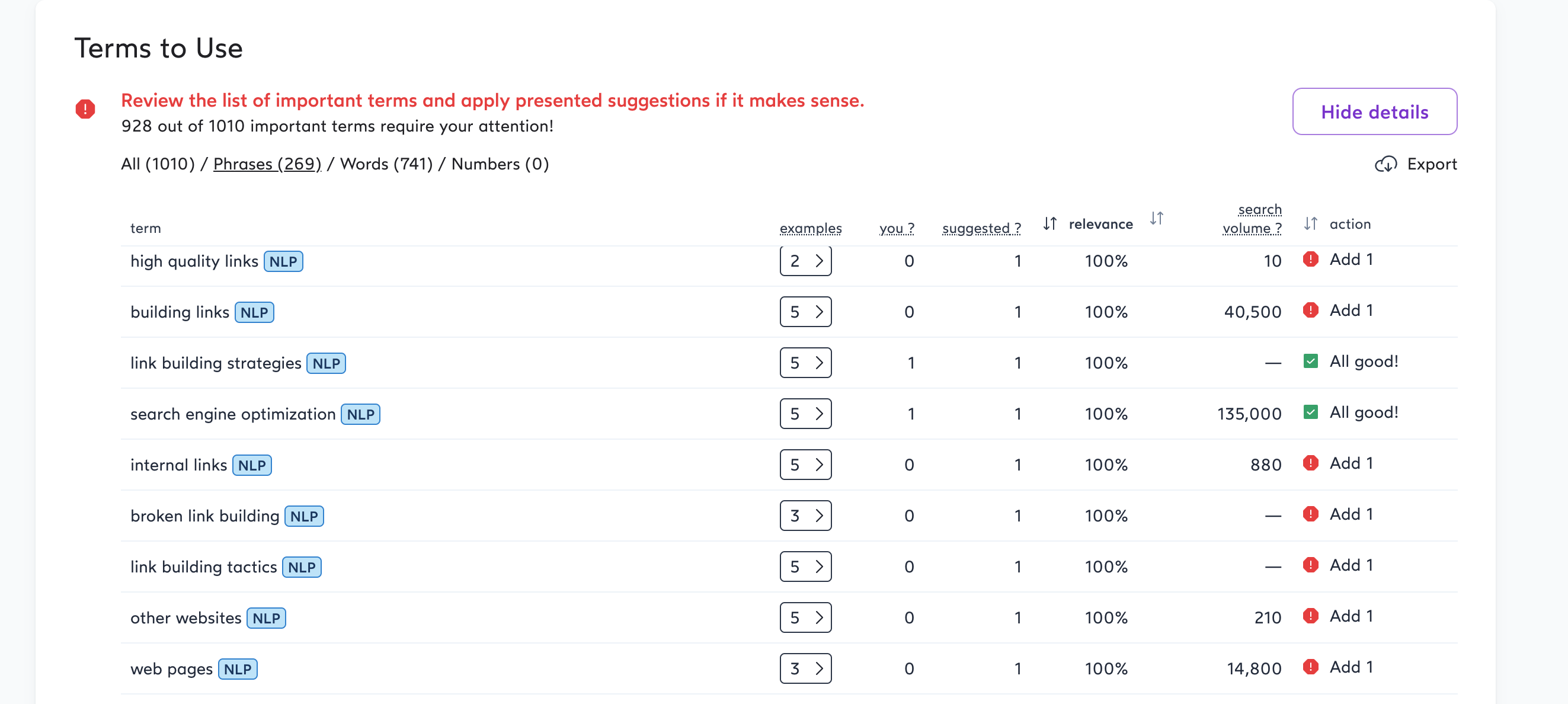In this guide, you’ll learn:
Link building seems simple enough.
“I’ll just build a bunch of backlinks, and rank higher in search engines.”
It begins innocently enough:
You do some research on link building to find:
- Best methods to use,
- Figure out who’s linking to your competitors, and
- Start putting together an outreach plan
But too often this process looks more like hours of grueling work than it does actual fun or success.
The reason?
Tasks like:
- Finding worthy prospects,
- Reaching out to them, and
- Converting them into links
is a lot more tedious than it looks.
You’ve to convince them enough to link to you even without an immediate benefit, and then hope it boosts your rankings.
Then, if that wasn’t enough, I’d inform you that outreach emails have a 5% to 8% conversion rate on average.
So the odds are stacked against you, to say the least.
None of this is meant to scare you, though.
Good news: I’m going to give you an in-depth look at how I build links for my personal projects and explain why most people are going about it all wrong.
So let’s begin with the first phase of a link building campaign which is:
#1: The Initial Draft
This is the pre-phase before starting your link-building campaign.
Before starting out, make sure your site is 100% ready and error-free.
If there are any broken links, poor quality content, 404s and other signs of technical problems then fix them up first.
These spiders are fierce!
They’re not going to let you rank high on Google with your unprofessional skills, or poor quality content, so fix them first.
And it all starts with:
#1.1. Having Linkable Assets On Your Blog
Do you know what makes a good linkable asset?
A good linkable asset is something that has the potential to be shared with others because it’s viral or if it benefits the population in some way.
A link placement comes with a value exchange between the publisher of the asset and the receiver.
If you don’t deliver value to their readers, why would they bother placing your link?
Having quality content that is properly optimized for your target keywords will certainly help, but this alone isn’t enough.
The better you can get at creating linkable assets that are related to your business, the easier it gets to get links.
It’s worth noting that linkable assets can take many forms.
It doesn’t necessarily mean text-only content; infographics and images also count here!
Here are some examples of some good linkable assets you can take advantage of to acquire links:
- Giveaways
- Case studies
- Skyscraper Blog Posts
- Infographics
- Statistical Posts
- How-to Guides
- List & Roundup Posts
- Free Tools
Having these assets will definitely help you acquire links, but you’ve to master the art of creating them.
After you’ve made sure that the content you want to build links to is GREAT, and is beneficial to others, it’s time to move onto the next step which is:
#1.2. Analyzing And Rectifying Your SEO And Site Issues
Conducting a full SEO audit (both on-page and technical) will help a lot in understanding your site’s overall situation.
This is where you’ll find out what are the current issues that you need to fix in order to acquire higher rankings in Google search results.
On-page SEO issues like:
- Image Optimization
- Internal Links
- Core Web Vitals & Page Speed
- Google Schema Optimization
- Title Tag, Meta Descriptions, Content Optimization, etc.
Need to be taken care of beforehand.
Similarly Technical Issues like:
- Mobile Friendliness
- HTTP errors
- Redirects
- Indexability
- Broken Links, Images, Redirects, etc.
Also, it needs to be taken care of.
To be honest, it is a lot of work to get all these things done.
Right?
Good News: It can all be automated and scheduled to run regularly.
With SEO tools like Ahrefs and Surfer SEO, you can conduct a full site and page-wise audit to find all the errors.
You can schedule them to run automatically on a weekly or daily basis, and stay updated about the changes.
Here’s how the audit reports look like:
Surferseo report

Ahrefs audit report

Once all on-page and technical SEO issues are fixed, it’s time to move on to finding target keywords for your link acquisition campaign!
#1.3. Research The Keywords You Want To Rank For
After you’ve rectified all the on-page and technical errors, it’s time to find out all the terms you want to rank for.
Selecting the keywords you want to build links to without a strategy and trying to rank for every keyword you can think of is one of the biggest SEO mistakes you can make.
It’s a way of “covering all bases”, but it doesn’t work.
The more keywords you target, the less time and effort you will be able to spend on each keyword which will lead to poor ROI.
The best way is to use SERP tracking tools or the plain old Google Search Console and figure out all the low-hanging fruits for your website.
Building quality links to low competition keywords will have a greater impact on your own website rankings and traffic rather than directly aiming for competitive ones.
To do this, follow the below steps in the particular order:
- Find all your keywords ranking on positions 2 to 20
- Conduct SEO audits on these pages
- Start building links to them
- Repeat
It’s easier to climb the ranks from the top 20 to the top 5 than it is from 80 to the top 5.
That’s why we at Getmentioned always chose the top 20 results.
Furthermore, as we create links to these low-competition keywords, your other pages will also begin to earn some authority.
As a consequence, your highly competitive keywords will also start to improve in rank without requiring direct linking.
And when those highly competitive terms will reach the top 20 or 30 spots on Google, you can repeat this method for them too.
The real beauty of link building is that it’s simple and repeatable.
After the keyword and target pages are decided, it’s time to:
#1.4. Perform A Comprehensive Competitor Audit
After you’ve selected the target keywords you want to create links to, you need to conduct a full competitor audit to further find hidden opportunities your competitors are leveraging.
This audit is done on 2 parameters namely:
- Target keywords and
- Competitor Backlink Analysis
With the help of SEO tools like Ahrefs, you can extract all the potential keywords your competition is ranking for.
The same you’ve to do is with their backlinks.
Understanding which keywords you’re leaving out on and using them ahead in your link building campaign will increase your search traffic.
And, with a comprehensive backlink audit, you’ll get a list of all the prospects who may link to you.
By now, you have got a full list of backlink profiles you can outreach to but that’s not enough.
You need to:
#1.5. Decide Which Types Of Websites You Need Links From
It’s important to decide which types of websites you need links from.
There are many different types of websites out there, and some will be more relevant than others for your business.
For example, if you’re a lawyer, it might be better to get a link from the website of another lawyer rather than getting one from an entertainment company or retailer.
How do we decide which website/blog post can pass you the link ROI?
At Getmentioned, we focus on mainly 4 parameters to decide if the website/blog post we are trying to build links from, is worthy of our efforts. Those are,
If that site/blog post:
Is Categorically Relevant – You don’t want a link to your entertainment website from an educational blog (which is completely irrelevant)
Has The Authority You Need – If the DA/DR of that site is lower than yours, it’ll hardly pass any value (unless it has quality traffic)
Has Some Current Organic Search Traffic – Having a DR of 90 is hardly beneficial if it has poor traffic levels
Has Adequate Link Quality – We make sure that we don’t add nofollow links, they’re do followed, permanent, and that page/blog post is accessible to crawl for the search engines
With the information provided above, we’re able to make an informed decision about what types of websites will be most valuable for your business.
You can use SEO tools like Ahrefs or Semrush to get DA/DR metrics, traffic potential, backlinks count, etc. that’ll help you make better-informed decisions.
Keep in mind that depending on your business, you’ll need different types of websites to build links from.
Since the types of sites are decided, you need to:
#1.6. Figure Out The Link Building Strategies You’ll Follow
You’ve decided the keywords you want to build links to, analyzed your competitor’s backlinks, ran a full audit, but what now?
You need to decide which link-building strategies you’ll follow and then create a checklist of all the tasks you’ll need to complete.
Normally, all the white hat link building techniques must follow 3 simple things and we at Getmentioned follow that strictly.
Those are:
- Value Exchange – Believe in giving value first
- Link Diversification – Don’t overuse or spam any particular link building strategy
- Building Real Personalized Relationships – Most important
The last thing you want is for Google to catch on and note down that all of your links are from guest posts.
Diversification is necessary since if Google sees that the only way you’ve got links is through guest postings (you must’ve bought them), it might place a penalty on your site.
So, DIVERSIFY as much as you can.
Finally, you need to decide which link-building strategy or technique you’ll follow.
You’ll notice that there are different variations, so you should try out all variants to see what works best for your website.
Some of them are:
- Blogger Outreach
- Link Exchange
- Guest blogging
- Broken link building
- Unlinked brand mentions
- Link reclamation
- Paid promotion for “linkable assets”
- Resource Pages
- Public Release and Content Submission
- Skyscraper technique
- Infographics
- Link Roundups
- Competitor Backlinks
- Editorial Links
- And more…
Wondering What’s Our Favorite Method?
We focus largely on:
- Authority links insertion and
- Editorial link building
#1.6.1. What’s Authority Link Insertion?
Authority Link Insertion is the process of adding links into existing authority content to your money pages.
What’s more, we add these links to relevant places in an article.
As a result, this helps us to save time and you get high-quality backlinks fast.
How do we find websites to place your links?
We use a mix of tactics, such as
- Competitor’s analysis,
- Resource link building,
- Skyscraper link-building tactic, etc.
Our approach is straightforward:
- If your material is attractively written and
- Includes unique information
There are hundreds of website owners who would be delighted to link to it in a relevant blog post.
Our work is to give it more exposure.
There is already a lot of excellent information on the internet, and there’s no need to spend more money developing new material and then including your links into it.
We add your links to existing content pages in such a way that it:
Adds value to that content,
Enhance content that currently ranks, and
Save money by not creating new content pieces for others
The last thing you want to do is spend money creating content just for the purpose of a link when you could invest those resources on your own site.
#1.6.2. What’s Editorial Link Building?
Editorial link building is the process of earning links from high-quality, authoritative business websites.
Unlike other forms of link building, editorial links are typically obtained by creating great content that publishers want to share with their audience.
The key goal is to develop links on real businesses’ blogs (these are typically SaaS firms in marketing-related fields).
This service is only for well-established brands, software companies, and organizations in the marketing sector.
You can try out our services if you’ve been developing links for years or are searching for anything better than run-of-the-mill general-category blogs that charge a guest post-administration fee.
How do we build all these links?
We capitalize on our industry connections, primarily to trade links with other marketers, which is beneficial for both parties, as to the links we trade are:
Relevant,
Instructive, and
Adds value to the current content
This method allows us to obtain “high DR” links from even those websites that do not sell links and almost never accept guest articles.
You can either perform the above methods yourself, or you can leverage our already built powerful network to get your link placements.
This is how we are able to save time and are able to skip the prospecting phase completely as we have relationships built already.
Proceeding to the next phase which is:
#2. Prospecting, Finding Contact Emails, And Performing Outreach
Prospecting is the process of identifying potential link opportunities.
This is further followed by finding their contact emails, performing outreach, and negotiating high-quality links.
But first, let’s start with:
#2.1. Finding Quality Prospects
To find quality prospects, you can either take the help of Google.
Since it’s highly time-consuming, we use Ahrefs content explorer tool.
You can follow these steps to get a list of 1000+ prospects within a minute:
- Go to Ahrefs content explorer
- Enter your niche keyword + intitle: “write for us” or try with intitle: “guest post”. Ex. finance + intitle: “guest post”
- You can then select the various filters like DR of the site, its language, is that post online or not, etc.
- To avoid getting the same website again and again (as you don’t want to pitch the same site twice), filter it to show one page per domain.
- And Voila! You’ll be having more than 1000 prospects waiting for you.
- Now just export the list as CSV

#2.2. Finding Contact Info
Phew!
That was a lot of hard work.
Isn’t it? ????????????????
Now just open that CSV in your Google Sheets and let Hunter add-on do its job i.e. finding the contact email for each prospect on automation.
Hunter will require:
- First name
- Last name
- Domain name of your prospects to get their email address.
All of this information will already be available in your exported CSV sheet from Ahrefs content explorer.
But if any of these fields are missing, you can either skip them or find their emails manually via LinkedIn or some other source.
To speed up and save time, I’ll recommend you just delete all the rows in your CSV file with missing info so we can focus on quality prospects.
After your CSV sheet has been cleaned up, run the Hunter add-on or simply take the file and upload it to the Hunter website.
It’ll automatically find the contact email of your prospects.

#2.3. Sending Emails
There’s good news: The bulk of the work is completed.
All that remains now is to upload the prospects to an outreach tool like Mailshake, Buzzstream, or Pitchbox.
After that, it’s simply a matter of creating a template with merge fields.
You could begin sending out emails left, right, and center without personalization at this step, but you’re basically just spamming the same message to hundreds of people.
That’s not going to work out well with a high-quality niche site.
So let’s keep personalization in mind as we move forward.

After you’ve crafted out the messages, all you need to do is
Hit SEND…
Congratulations, you sent those pitch emails.
Now you need some patience.
If you hear back a response.
Good
Try to take that convo ahead and close the deal.
Else, it’s the time for:
#2.5. Following Up
Many times, you’ll not hear from your prospects at once.
They might not pick up the phone right away, or their inbox is flooded with messages.
This happens to me all the time.
This is why you should always follow up.
When it comes to following up, there’s a sweet spot between being too persistent and not being persistent enough (but that’s another topic).
After 2 -3 follow-ups, chances are you’ll hear something from them.
At this time, the prospect will either say no or they’ll tell you they need to discuss internally.
If they say no, great!
You don’t need to waste your time providing a proposal.
If they tell you they want to discuss it with their team, that’s your chance for breaking the ice and closing the deal.
If you’ve got good negotiation and communication skills, chances are you’ll be able to land a few links for yourself.
But how will you measure their impact on your website?
To do that, you’ll need to:
#3. Track, Analyze, And Measure Your Link Building Efforts
Thankfully, after grueling hours of work, you finally got a link or two.
But how do you know if your link-building efforts are working?
Rankings in Google doesn’t mean your link building efforts worked.
Your rankings may have been a result of something else, such as
- A new Google update,
- Seasonal search patterns, or
- Changes to your keyword strategy
In order to know if your link-building efforts are working, you need to track and analyze the results they’re contributing to.
This will help you determine how much credit (if any) is due to your outreach activities.
But How Do You Measure These Results?
It’s simple.
You need 4 metrics to measure the effectiveness of your link building efforts and those are:
- Backlinks and Referring Domains Count
- Domain Authority
- Organic Website Traffic
- SERP Rankings
If the link building performed is white hat, you’ll witness huge increments in all 4 parameters simultaneously.
You can also track your keywords using SERP tracking tools for specific niches to see which of the links you’ve earned are driving traffic and conversions.
To smoothen your tracking, a spreadsheet should be updated on a monthly basis so you can track your
- Backlink growth,
- Organic traffic spikes, and
- SERP ranking changes
Such detailed reports will help you understand the impact of your link-building efforts which can be then used to refine your process further or try out new strategies.
Note: It’s easy to take a website from DR 2 to DR 10 with just 2 or 3 high DR links, but it can take you 50-60 links to go from DR 70 to 71.
So don’t panic if you’re investing huge time and money and aren’t seeing your DR increase that fast if you’re already above DR 60.
The DR growth begins to slow down as your website authority starts to build up.
General FAQs Regarding Link Building Strategy And Ranking High On Search Engines
What are the link-building techniques?
Few link building techniques include:
- Blogger Outreach
- Skyscraper technique
- Guest blogging
- Unlinked brand mentions
- Public Release and Content Submission
- Link Exchange
- Infographics
- Competitor Backlinks
- Editorial Links
- Broken link building
- Link reclamation
- Link Roundups
- Resource Pages
- Paid promotion for “linkable assets”
- And more…
Does link building still work in 2022?
Link building still works.
Likely it’ll be at a reduced capacity than during the height of the algorithm changes in 2022, but we’re living in an era where links still do matter to Google and there’s no point in giving up on them just yet.
Link building isn’t dead, and it doesn’t seem like this will happen anytime soon.
How do you create a link-building strategy?
To create a link-building strategy, you need to know the various ways you can get high-quality backlinks.
Then you need to compare them.
It’s not just about the number of backlinks, but also the quality.
Having said that, building links is hard work.
You need to constantly monitor your search engine rankings, backlink profile, and industry news for potential opportunities.
To create a successful strategy you must first identify the type of links you want to get.
Furthermore, you must be patient and consistent because you get nothing for free in the world of SEO.
You will get your rewards if you consistently put in the time to create high-quality content and contribute to online communities both within your niche and outside it.
What is the link building process?
The process of link building is a method of driving quality traffic back to your site from external sources.
Links built through white-hat strategies are generally looked upon more favorably in both the short and long terms than those built with black-hat or spam techniques, though this is not always the case, so it’s important to employ a variety of strategies to ensure longevity.
In order for search engines to crawl your web pages properly and give them a “signal,” they need textual information from other pages.
The trick then becomes providing a chain of text that reaches outside your domain into relevant places on the web without looking too unnatural or using deceitful practices that would alert Google’s spam team.
This can be done by reaching out directly to websites through contacts to build links or hiring someone to do that for you.
Try our Link building services now.
Wrapping Up The Link Building Checklist
To summarize, link building is a vital component of any SEO strategy.
If you want to rank well in Google search results and stay competitive with other businesses within your industry, then you need links from high authority sites that are relevant to your company’s field.
Getting these types of links will take hard work and perseverance, but our team at Getmentioned can help you by offering high-quality services such as white hat link trading and blog placement that will bring you quality interactions throughout the internet.
If you’re a digital marketing consultant looking to provide value to your clients with SEO, this link-building checklist will help you maximize results and output.
In short, you should follow this simple checklist to smoothen your link building journey:
Phase 1: The Initial Draft
- Start With Having Linkable Assets On Your Blog
- Analyze And Rectify Your SEO And Site Issues
- Research The Keywords You Want To Rank For
- Perform A Comprehensive Competitor Audit
- Decide Which Types Of Websites You Need Links From
- Mention The Link Building Strategies You’ll Follow
Phase 2: Prospecting, Finding Contact Emails, And Performing Outreach
- Find Quality Prospects
- Find Their Contact Info
- Send Emails
- Follow Up
Phase 3: Tracking, Analyzing, And Measuring Your Link Building Efforts
You need to track 4 things:
- Backlinks and Referring Domains Count
- Domain Authority
- Organic Website Traffic
- SERP Rankings
This is link building achieved in 3 phases.
I hope this article has provided you with some great link-building tips.
If you are looking for any help with your link-building efforts, reach out to us to see how we can assist you.
Till then, happy link building!







 View another articles
View another articles